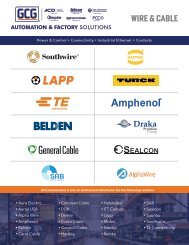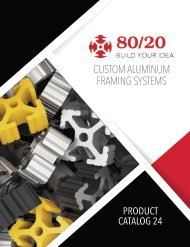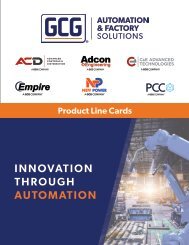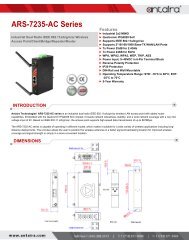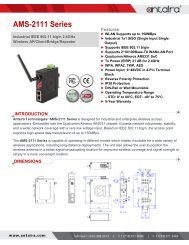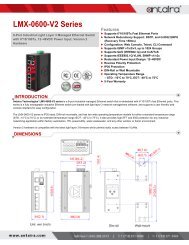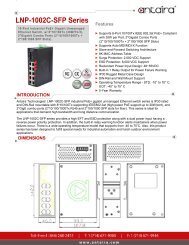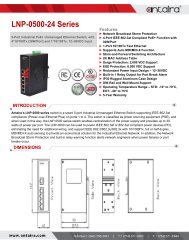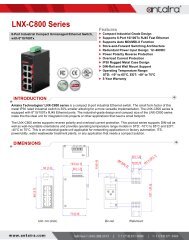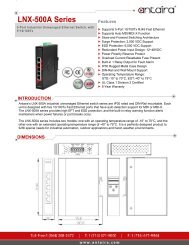Socomec UL General Catalog
Create successful ePaper yourself
Turn your PDF publications into a flip-book with our unique Google optimized e-Paper software.
Fuse solutions: definite advantages<br />
over circuit breakers<br />
Fusible<br />
disconnect switches<br />
fuser_185_e_gb<br />
Fuses: a high performance<br />
kA<br />
Fuse<br />
Prospective<br />
short circuit<br />
current<br />
time<br />
ms<br />
Due to the high current limiting<br />
CC, J and L type fuses, the best<br />
protection will be provided to<br />
downstream components, such as<br />
motor or motor starter.<br />
Our disconnects have been<br />
designed around this concept to<br />
provide 200kA as a SCCR on<br />
most of the range.<br />
fuser 192 b<br />
Safety<br />
The energy released during a short-circuit is<br />
contained in the sealed fuse cartridge, there is<br />
no release of ionized gases, thus no effect on<br />
surrounding equipment in comparison to what<br />
happens when circuit-breakers open on shortcircuit.<br />
fuser 487 a gb<br />
Circuit-breakers:<br />
reduced breaking capacity<br />
Current kA<br />
Circuit breaker<br />
Fuse<br />
Voltage<br />
Breaking capacity of circuitbreakers<br />
reduces dramatically<br />
when voltage increases: capacity<br />
can decrease from 100kA at<br />
240V to 20kA or even less at<br />
600 V.<br />
fuser 490 d gb<br />
Reliability over time<br />
Reliability<br />
Circuit breaker<br />
Fuse<br />
Time<br />
Fuses are totally sealed<br />
products, which guarantee longterm<br />
protection without any<br />
maintenance.<br />
Circuit-breakers are complex<br />
devices including lots of moving<br />
parts. Their mechanism is affected<br />
by dust, humidity… and needs<br />
maintenance.<br />
fuser 664 a<br />
Re-close or Replace ?<br />
Circuit-breakers can be re-closed after<br />
a default: that’s the biggest argument of<br />
their manufacturers.<br />
You should however consider that the<br />
circuit-breaker should be inspected each<br />
time there is a significant short-circuit.<br />
It is hard to know how many times a<br />
circuit-breaker has operated…<br />
In contrast, when a fuse blows, it is<br />
replaced by a new one, and the installation<br />
is as relia ble as prior to the fault.<br />
Thus, Re-close or replace ?<br />
fuser 610 a<br />
Last longer<br />
Our FUSERBLOC show 2 main<br />
functionalities:<br />
magneto-thermal protection, made<br />
inside the encapsulated fuses,<br />
disconnection thru moving contacts<br />
that stay closed during short-circuit<br />
(arc won’t destroy them).<br />
On a circuit-breaker both functionality<br />
are on the same mechanical element.<br />
Evolution of NEC ® regulation<br />
Requirement of panel sccr<br />
Art 409 of NEC ® 2005 & <strong>UL</strong> 508A<br />
According to NEC ® 2005, all industrial control panels must be<br />
marked with a Short-Circuit Current Rating (SCCR).<br />
This covers the entire panel and not just the primary rating of the<br />
over-current protection device, as commonly done before.<br />
Calculation of this Panel SCCR is easy with Fuse Disconnect<br />
Switch, since there is a defined table SB4.1 in <strong>UL</strong> 508 which<br />
specifies Ip (peak value) of feeder fuse that can be used for<br />
protection of downstream components, which is not the case on<br />
circuit-breakers. Thanks to the high current limiting characteristics<br />
of the fuses the SCCR of brauch circuits can be highly enhanced.<br />
Arc flash NEC ® 2005<br />
The NEC now contains requirements related to arc flash<br />
hazards. Section 110-16, Flash Protection, requires markings on<br />
switchboard, panel boards, industrial control panels and motor<br />
control centers to warn from potential arc flash hazards.<br />
Arc flash mitigation is greatly enhanced by the use of fuses and<br />
their current limiting capabilities and fast opening times.<br />
92 <strong>General</strong> <strong>Catalog</strong> <strong>UL</strong>/CSA Ed. 2



